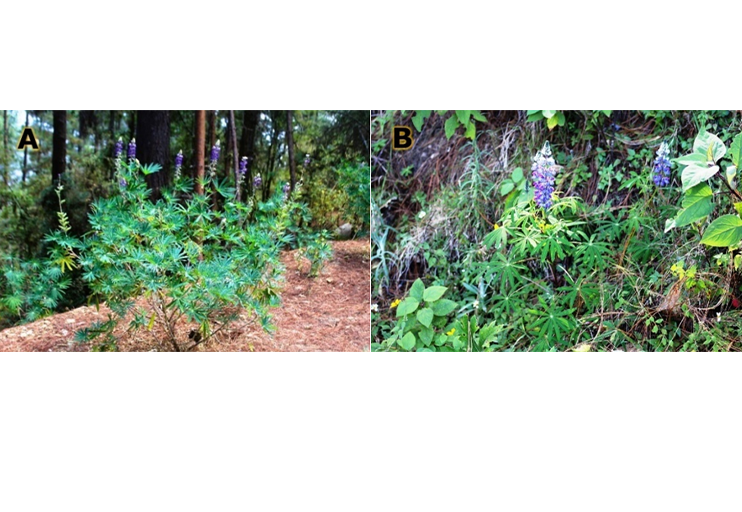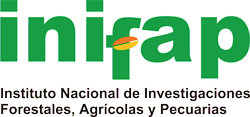Mycorrhization of Lupinus spp. in nursery to improve the development of plants in ecological restoration strategies
DOI:
https://doi.org/10.29312/remexca.v16i2.3504Keywords:
fixation of nitrogen, nurse plants, Rhizophagus irregularis, symbiosisAbstract
The species of the genus Lupinus are considered to be of great ecological and nutritional importance due to their ability to fix atmospheric nitrogen to the soil and to the high content of proteins (seeds), fibers (leaves), sugars (leaves), and minerals (seeds). The present study aimed to evaluate the development of Lupinus montanus and L. campestris as a response to seed mycorrhization. Inoculation was performed with Rhizophagus irregularis-BIOFertilizante INIFAP®. The treatments were 400 inoculated plants (200 per species) and 400 without inoculation, which were considered as controls. The variables evaluated were growth in basal diameter (mm), total height (cm), and nodule production one year after establishment. The experiment was conducted in January 2022 at the nursery of the Faculty of Forestry Sciences of the Autonomous University of Nuevo León, in Linares, Nuevo León, Mexico. The average growth in plants with mycorrhization showed a difference of 20% in basal diameter and 14% in height in L. montanus, whereas in L. campestris, it was 5% in basal diameter and 4% in height. In nodule production, a difference of 12.5% was observed in L. montanus and 28% in L. campestris compared to uninoculated seeds (control). The mycorrhization of the seeds had a significant impact (p< 0.001) on the development of Lupinus and its growth characteristics one year after its establishment. Both L. campestris and L. montanus are ideal for use in ecological restoration strategies because they generate beneficial microhabitats for the associated species.
Downloads
References
Bibliografía
Aerts, R.; Negussie, A.; Maes, W.; November, E.; Hermy, M. and Muys, B. 2007. Restoration of dry afromontane forest using pioneer shrubs as nurse-plants for Olea europaea ssp. cuspidata. Restoration Ecology. 15(1):129-138. http://dx.doi.org/10.1111/j.1526-100X.2006.00197.x
Águila, S. I.; Vázquez, C. O.; López, U. J.; López, L. A.; Martínez, R. E.; García, G. E. y Zamora, C. E. M. 2018. Variación morfológica y reproductiva de nueve poblaciones naturales de Lupinus campestris Schltdl. & Cham., de la región centro oriente de Puebla, México. Revista Científica Biológico-Agropecuaria Tuxpan. 6(2):89-95. https://doi.org/10.47808/revistabioagro.v6i2.Especial.261.
Barrientos, D. L.; Montenegro, B. A. y Pino, N. I. 2002. Evaluación de la fijación simbiótica de nitrógeno de Lupinus albus y L. angustifolius en un Andisol Vilcun del sur de Chile. Terra Latinoamericana. 20(1):39-44. https://www.redalyc.org/articulo.oa?id=57320107.
Bermúdez, T. K.; Robledo. Q. N.; Martínez. H. J.; Andreas, T. and Wink, M. 2000. Biodiversity of the genus Lupinus in Mexico. In: Van Santen, E. M.; Wink, S. Weissmann y Römer, P. Ed. In: Proceedings 9th International Lupin Conference. International Lupin Association. Klink/Müritz, Germany. 294-296 pp.
Carrillo-Saucedo, S. M.; Puente-Rivera, J.; Montes-Recinas, S.; Cruz-Ortega, R. 2022. Las micorrizas como una herramienta para la restauración ecológica. Acta Botánica Mexicana. 129:1-27. Doi.org/10.21829/abm129.2022.1932.
Ferrari, A. E. y Wall, L. G. 2004. Utilización de árboles fijadores de nitrógeno para la revegetación de suelos degradados. Revista de la Facultad de Agronomía. 105(2):63-87. https://dialnet.unirioja.es/servlet/articulo?codigo=2007388.
Fungorum. 51:e1320. https://doi.org/10.33885/sf.2021.51.1320.
Gómez-Romero, M.; Villegas, J.; Sáenz-Romero, C. y Lindig-Cisneros, R. 2013. Efecto de la micorrización en el establecimiento de Pinus pseudostrobus en cárcavas. Madera y Bosques. 19(3):51-63. https://doi.org/10.21829/myb.2013.193327.
Liriano, G. R.; Núñez, S. D. B. y Barceló, D. R. 2012. Efecto de la aplicación de Rhizobium y Mycorriza en el crecimiento del frijol (Phaseolus vulgaris L) variedad CC-25-9 negro. Centro Agricola. 39(4):17-20.
Masson-Boivin, C. and Sachs, J. L. 2018. Symbiotic nitrogen fixation by rhizobia-the roots of a success story. Current Opinion in Plant Biology. 44:7-15. Doi.org/ 10.1016/j.pbi.2017.12.001.
Mendoza-Hernández, P. E.; Orozco-Segovia, A.; Meave, J. A.; Valverde, T. and Martínez-Ramos, M. 2013. Vegetation recovery and plant facilitation in a human-disturbed lava field in a megacity: searching tools for ecosystem restoration. Plant Ecology. 214:153-167. http://dx.doi.org/10.1007/s11258-012-0153-y.
Montes-Rivera, G.; Solís-González, S.; Quintos-Escalante, M. 2001. Efecto del inoculante comercial BURIZE® (Glomus intraradices) sobre el desarrollo de Pinus engelmannii Carr. Revista Chapingo Serie Ciencias Forestales y del Ambiente. 7(2):123-126.
Pablo-Pérez, M.; Lagunes-Espinosa, L. C.; López-Upton, J.; Ramos-Juárez, J. y Aranda-Ibáñez, E. 2013. Morfometría, germinación y composición mineral de semillas de Lupinus silvestres. Bioagro. 25(2):101-108. http://ve.scielo.org/scielo.php?script=sci-arttext&pid=S1316-33612013000200003.
Pablo-Pérez, M.; Lagunes-Espinoza, L. C.; López-Upton, J.; Aranda-Ibáñez, E. M. y Ramos-Juárez, J. 2015. Composición química de especies silvestres del género Lupinus del estado de Puebla, México. Revista Fitotecnia Mexicana. 38(1):49-55.
R Core Team. 2023. R: a language and environment for statistical computing. R. Foundation for Statistical Computing. Vienna, Austria. https://www.r-project.org/.
Ramírez-Contreras, A. y Rodríguez-Trejo, D. A. 2009. Plantas nodriza en la reforestación con Pinus hartwegii Lindl. Revista Chapingo Serie Ciencias Forestales y del Ambiente. 15(1):43-48. https://www.redalyc.org/articulo.oa?id=62916073010.
Rodas, C. A.; Núñez, E. R.; Espinoza, H. V. y Alcantar, G. G. 2001. Asociación lupino-maíz en la nutrición fosfatada en un andosol. Terra. 19(2):141-154. https://www.redalyc.org/pdf/573/57319205.pdf.
Rzedowski, G. C. y Rzedowski, J. 2005. Flora fanerogámica del Valle de México. 2a Ed. Instituto de Ecología y Comisión Nacional para el Conocimiento y Uso de la Biodiversidad. Pátzcuaro, Michoacán, México, DF. 1404 p.
Sujak, A.; Kotlarz, A. and Strobel, W. 2006. Compositional and nutritional evaluation of several lupin seeds. Food Chemistry. 98(4):711-719. http://dx.doi.org/10.1016/j.foodchem.2005.06.036.
Trejo, D.; Hernández-Acosta, E.; Baeza-Guzmán, Y.; Pérez-Toledo, G.; Morgado-Viveros, E. and Bañuelos, J. 2021. Efectividad de los hongos micorrízicos arbusculares introducidos y nativos en seis leguminosas coberteras. Scientia. 51:1-13. https://doi.org/10.33885/sf.2021.51.1320.
Weisany, W.; Raei, Y. and Allahverdipoor, K. H. 2013. Role of some of mineral nutrients in biological nitrogen fixation. Bulletin of Environment, Pharmacology and Life Sciences. 2(4):77-84. Doi.org/10.1016/B978-0-443-18675-2.00004-3.
Zamora-Natera, J. F.; Zapata-Hernández, I. y Villalvazo-Hernández, A. 2019. Fijación biológica del nitrógeno en tres especies silvestres del género Lupinus (Leguminosae, Papilionoideae) en México. Acta Botánica Mexicana. 126:e1543. http://dx.doi.org/10.21829/abm126.2019.1543.

Published
How to Cite
Issue
Section
License
Copyright (c) 2025 Revista Mexicana de Ciencias Agrícolas

This work is licensed under a Creative Commons Attribution-NonCommercial 4.0 International License.
The authors who publish in Revista Mexicana de Ciencias Agrícolas accept the following conditions:
In accordance with copyright laws, Revista Mexicana de Ciencias Agrícolas recognizes and respects the authors’ moral right and ownership of property rights which will be transferred to the journal for dissemination in open access. Invariably, all the authors have to sign a letter of transfer of property rights and of originality of the article to Instituto Nacional de Investigaciones Forestales, Agrícolas y Pecuarias (INIFAP) [National Institute of Forestry, Agricultural and Livestock Research]. The author(s) must pay a fee for the reception of articles before proceeding to editorial review.
All the texts published by Revista Mexicana de Ciencias Agrícolas —with no exception— are distributed under a Creative Commons License Attribution-NonCommercial 4.0 International (CC BY-NC 4.0), which allows third parties to use the publication as long as the work’s authorship and its first publication in this journal are mentioned.
The author(s) can enter into independent and additional contractual agreements for the nonexclusive distribution of the version of the article published in Revista Mexicana de Ciencias Agrícolas (for example include it into an institutional repository or publish it in a book) as long as it is clearly and explicitly indicated that the work was published for the first time in Revista Mexicana de Ciencias Agrícolas.
For all the above, the authors shall send the Letter-transfer of Property Rights for the first publication duly filled in and signed by the author(s). This form must be sent as a PDF file to: revista_atm@yahoo.com.mx; cienciasagricola@inifap.gob.mx; remexca2017@gmail.
This work is licensed under a Creative Commons Attribution-Noncommercial 4.0 International license.


